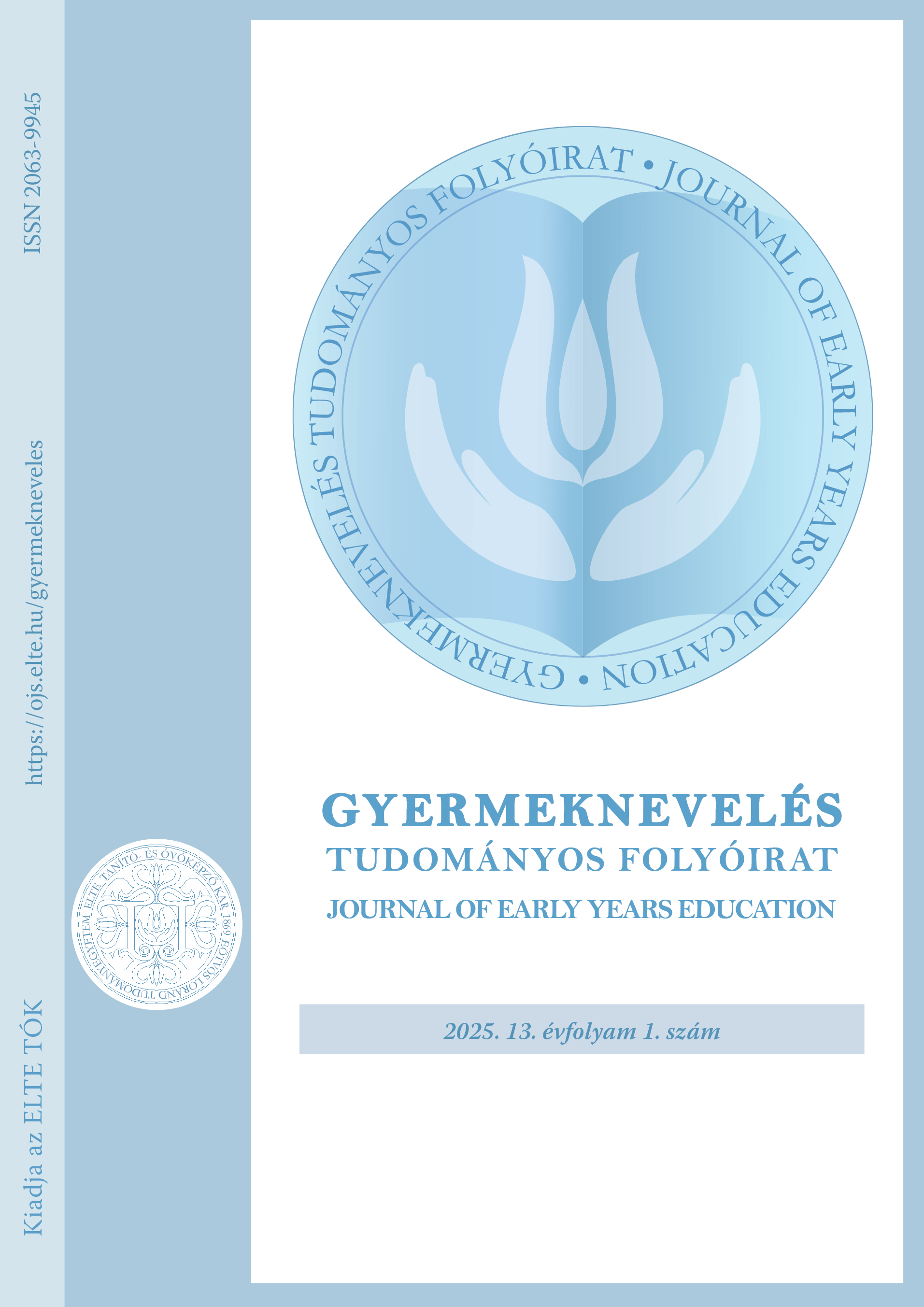Esszenciális ábrák szerepe egy fejlesztő kísérlet keretein belül
DOI:
https://doi.org/10.31074/gyntf.2025.1.5.19Kulcsszavak:
esszenciális ábrák, fejlesztő kísérlet, szöveges feladatok, problémamegoldás, alsó tagozatAbsztrakt
Tanulmányunkban egy fejlesztő kísérlet eredményeiről számolunk be, ami egy, a budai agglomerációban található általános iskola 3. évfolyamán zajlott. Kutatásunk központjában az esszenciális (Berends & Van Lieshout, 2009) ábrákat tartalmazó szöveges matematikai feladatok megoldásának segítése állt. Kísérletünk célja az volt, a tanulók 12 saját fejlesztésű feladatpár feldolgozása során találkozzanak egy-egy esszenciális ábrával, melynek tanulmányozása nélkülözhetetlen a sikeres feladatmegoldáshoz. Eredményül azt vártuk, hogy a kísérletben részt vett tanulók körében magasabb lesz a megoldottsága az ilyen típusú szöveges matematikai feladatoknak, és hogy nő a realisztikus válaszok aránya a realisztikus (Verschaffel, 2009) szöveges feladatok megoldása során. A kísérlet eredményeként tendenciózusan nőtt a kísérleti csoportban a realisztikus szöveges feladatokra adott realisztikus válaszok aránya, és kimutatható fejlesztő hatást értünk el egy PISA 2003-as hiányos szövegezésű feladat megoldottságában. Eredményeink a matematikadidaktika, a problémamegoldás területén fontos adalékul szolgálhatnak a gyakorló pedagógusok és a matematika módszertani képzés számára.
Letöltések
Hivatkozások
Berends, I. E. & Van Lieshout, E. C. (2009). The effect of illustrations in arithmetic problem-solving: Effects of increased cognitive load. Learning and Instruction, 19(4), 345–353. https://doi.org/10.1016/j.learninstruc.2008.06.012
Cummins, D. D. (1991). Children’s interpretations of arithmetic word problems. Cognition and instruction, 8(3), 261–289. https://doi.org/10.1207/s1532690xci0803_2
Csapó, B. (2003). A képességek fejlődése és iskolai fejlesztése. Akadémiai Kiadó.
Csíkos, Cs. (2003). Matematikai szöveges feladatok megértésének problémái 10–11 éves tanulók körében. Magyar Pedagógia, 103(1), 35–55.
Csíkos, Cs. (2008). Mentális modellek és metareprezentációk matematikai szöveges feladatok megoldásában. Egy fejlesztőkísérlet elméleti alapjai. In Kozma, T. & Perjés, I. (Eds.), Új kutatások a neveléstudományokban (pp. 109–117). MTA Pedagógiai Bizottság.
Csíkos, Cs., Szitányi, J. & Kelemen, R. (2010). Vizuális reprezentációk szerepe a matematikai problémamegoldásban. Egy 3. osztályos tanulók körében végzett fejlesztő kísérlet eredményei. Magyar Pedagógia, 110(2), 149–166.
Csíkos, Cs. (2012). Pedagógiai kísérletek kutatásmódszertana. Gondolat.
Csíkos, C. & Szitányi, J. (2020). Teachers’ pedagogical content knowledge in teaching word problem solving strategies. ZDM, 52(1), 165–178. https://doi.org/10.1007/s11858-019-01115-y
Csíkos, C., Szitányi, J. & Kelemen, R. (2012). The effects of using drawings in developing young children’s mathematical word problem solving: A design experiment with third-grade Hungarian students. Educational Studies in Mathematics, 81, 47–65. https://doi.org/10.1007/s10649-011-9360-z
Csíkos, C. & Verschaffel, L. (2011). Mathematical literacy and the application of mathematical knowledge. Framework for diagnostic assessment of mathematics, 57–93.
De Corte, E., Verschaffel, L. & Op’t Eynde, P. (2000). Self-regulation: A characteristic and a goal of mathematics education. In Handbook of self-regulation (pp. 687–726). Academic Press. https://doi.org/10.1016/B978-012109890-2/50050-0
Dewolf, T., Van Dooren, W., Hermens, F. & Verschaffel, L. (2013, July). Do students attend to and profit from representational illustrations of non-standard mathematical word problems? In Proceedings of the 37th Conference of the International Group for the Psychology of Mathematics Education (Vol. 2, pp. 217–224).
Elia, I. & Philippou, G. (2004). The Functions of Pictures in Problem Solving. International group for the psychology of mathematics education.
Hegarty, M. & Kozhevnikov, M. (1999). Types of visual–spatial representations and mathematical problem solving. Journal of Educational Psychology, 91(4), 684. https://doi.org/10.1037/0022-0663.91.4.684
Hidayatullah, A. & Csíkos, C. (2023). Students’ responses to the realistic word problems and their mathematics-related beliefs in primary education. Pedagogika, 150(2), 21–37. https://doi.org/10.15823/p.2023.150.2
Kelemen, R. (2004). Egyes háttérváltozók szerepe „szokatlan” matematikai szöveges feladatok megoldásában. Iskolakultúra, 14(11), 28–38.
Kelemen, R. (2006). Nemzetközi tendenciák a matematikai szöveges feladatok elméletében. Iskolakultúra, 16(1), 56–65.
Kelemen, R. (2007). Fejlesztő kísérletek a realisztikus matematikai problémák megoldásában. Iskolakultúra, 6, 7.
Mayer, R. E. & Hegarty, M. (2012). The process of understanding mathematical problems. In The nature of mathematical thinking (pp. 29–53). Routledge.
McNeil, N. M., Uttal, D. H., Jarvin, L. & Sternberg, R. J. (2009). Should you show me the money? Concrete objects both hurt and help performance on mathematics problems. Learning and Instruction, 19(2), 171–184. https://doi.org/10.1016/j.learninstruc.2008.03.005
Morris, S. B. (2005). Effect size estimation from prestest–posttest–control designs with heterogeneous variances. Paper presented at the 20th Annual Conference of the Society for Industrial and Organizational Psychology, Los Angeles, CA.
OECD (2004). Learning for tomorrow’s world: First results from PISA 2003. https://doi.org/10.1787/9789264006416-en
OECD (2006). PISA released items – Mathematics. https://www.oecd.org/pisa/38709418.pdf (2025. 01. 30.)
Schnotz, W. (2002). Commentary: Towards an integrated view of learning from text and visual displays. Educational Psychology Review, 14, 101–120. https://doi.org/10.1023/A:1013136727916
Turzó-Sovák, N., Berecki, I., Csíkos, Cs. & Hidayatullah, A. (2025). Cognitive metacognitive and affective factors behind performance on a PISA task; A Hungarian-Indonesian comparative study (submitted for publication).
Viitala, H. (2015). Two Finnish girls and mathematics: Similar achievement level, same core curriculum, different competences. LUMAT: International Journal on Math, Science and Technology Education, 3(1), 137–150. https://doi.org/10.31129/lumat.v3i1.1056
Verschaffel, L. & De Corte, E. (1997). Word problems: A vehicle for promoting authentic mathematical understanding and problem solving in the primary school? In T. Nunes & P. Bryant (Eds.), Learning and teaching mathematics: An international perspective (pp. 69–97). Psychology Press.
Verschaffel, L., De Corte, E., Lasure, S., Van Vaerenbergh, G., Bogaerts, H. & Ratinckx, E. (1999). Design and evaluation of a learning environment for mathematical modeling and problem solving in upper elementary school children. Mathematical Thinking and Learning, 1(3), 195–230. https://doi.org/10.1207/s15327833mtl0103_2
##submission.downloads##
Megjelent
Hogyan kell idézni
Folyóiratszám
Rovat
License
Copyright (c) 2025 Szerző

This work is licensed under a Creative Commons Attribution-NonCommercial-ShareAlike 4.0 International License.

